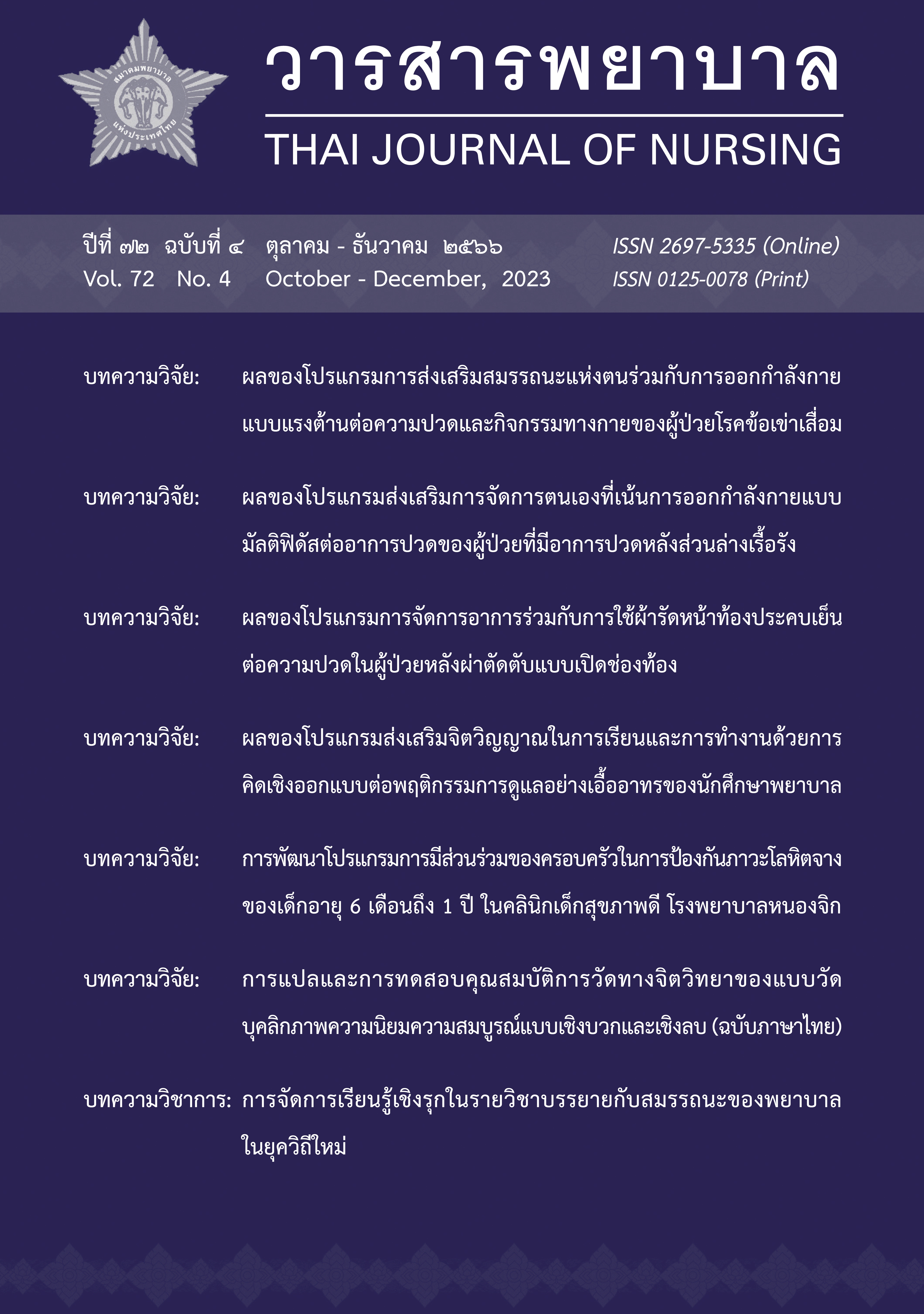The effect of symptom management program combined with abdominal binder with cold compression on pain in patients with open hepatectomy
Main Article Content
Abstract
This quasi-experimental study aimed to examine effect of symptom management program combined with abdominal binder with cold compression on pain in patients after open hepatectomy. Participants in the present study were 44 patients undergoing open hepatectomy treated in surgery ward, King Chulalongkorn Memorial Hospital. All of them were adult patients who met the inclusion criteria. They were matched pairs by gender ,age, history of surgery and type of analgesics. The control group (n=22) receive routine nursing care while experimental group (n = 22) receive routine nursing care with symptom management program combined with abdominal binder with cold compression that developed based on the concept of Dodd et al. Research tools were symptom management program combined with abdominal binder with cold compression and visual analog scale. Data were analyzed using descriptives statistics and t-test. The result concluded that the mean score of pain at the posttest, of the experimental group was significantly lower than that of the control group (p < .05).
Article Details

This work is licensed under a Creative Commons Attribution-NonCommercial-NoDerivatives 4.0 International License.
References
กรสกุล บุญเพลิง, สมศักดิ์ ประฏิภาณวัตร และทุมวดี ตั้งศิริวัฒนา. (2564). การใช้ที่รัดหน้าท้องเพื่อฟื้นฟูสมรรถภาพและการเคลื่อนไหวหลังการผ่าตัดโรคทางนรีเวชวิทยาผ่านหน้าท้อง: การทดลองแบบสุ่ม. Thai Journal of Obstetrics and Gynaecology, 29(1), 10-16.
เกศริน อินธิยศ, วัลย์ลดา ฉันท์เรืองวณิชย์, เกศศิริ วงษ์คงคำ, และชินา โอฬารรัตนพันธ์. (2564). ผลของโปรแกรมการจัดการความปวดด้วยการประคบเย็นร่วมกับการใช้ผ้ารัดหน้าท้องต่อระดับความปวดและการเคลื่อนไหวร่างกายหลังผ่าตัดในผู้ป่วยนรีเวชที่ได้รับการผ่าตัดแบบเปิดหน้าท้อง. วารสารสภาการพยาบาล, 36(3), 83-102.
จุฑารัตน์ สว่างชัย, ชุลีพร ปิยสุทธิ์, และศิริพร แก้วกุลพัฒน์. (2562). การจัดการความปวดแบบผสมผสาน: การตั้งเป้าหมายระดับความปวดหลังผ่าตัด. วารสารวิทยาลัยพยาบาลบรมราชชนนี อุตรดิตถ์, 11(2), 161-171.
จุฑารัตน์ สว่างชัย และ ศรีสุดา งามขำ. (2560). ความปวดของผู้ป่วยหลังผ่าตัดช่องท้องโรงพยาบาลสวรรค์ประชารักษ์. วารสารวิจัยทางวิทยาศาสตร์สุขภาพ, 11, 1-11.
เพ็ญประภา อิ่มเอิบ, วรีวรรณ คงชุ่ม, และกรณิศ หริ่มสืบ. (2557). ผลของดนตรีบรรเลงต่อระดับความปวดในผู้ป่วยหลังผ่าตัดศัลยกรรมทั่วไป. วารสารพยาบาลกระทรวงสาธารณสุข, 23(3), 53-62.
โรงพยาบาลจุฬาลงกรณ์ แผนกเวชระเบียนและสถิติ. (2564). สถิติผู้ป่วยใน. แผนกเวชระเบียนและสถิติ โรงพยาบาลจุฬาลงกรณ์.
วัลยาณี เนื่องโพธิ์, สุกัญญา ศรีนิล, ทุมวดี ตั้งศิริวัฒนา, และมาลีชาติ ศรีพิพัฒนกุล. (2561). การศึกษาทดลองแบบสุ่มเรื่องการใช้ถุงเจลเย็นเพื่อลดระดับความเจ็บปวดหลังผ่าตัดในผู้ป่วยนรีเวชที่ไม่ใช่มะเร็ง. Thai Journal of Obstetrics and Gynaecology, 26(1), 52-58.
ศศินาภรณ์ โลหิตไทย และบุญยิ่ง ทองคุปต์. (2562). ผลของรูปแบบผ้ารัดหน้าท้องประคบเย็นต่อความปวดแผลผ่าตัดในมารดาหลังคลอดทางหน้าท้อง. วารสารคณะพยาบาลศาสตร์ มหาวิทยาลัยบูรพา, 27(1), 23-32.
สราวุฒิ สีถาน. (2560). ผลของโปรแกรมการเตรียมความพร้อมก่อนผ่าตัดต่อการฟื้นตัวในผู้ป่วยหลังผ่าตัดช่องท้อง. วารสาร มฉก.วิชาการ, 20(40), 101-113.
สิรานันท์ จันทร์ชุม, วิภา แซ่เซี้ย, และประณีต ส่งวัฒนา. (2565). การจัดการและผลลัพธ์การจัดการความปวดในผู้ป่วยหลังผ่าตัดหรือช่องท้อง. พยาบาลสาร มหาวิทยาลัยเชียงใหม่, 49(3), 188-202.
Arici, E., Tastan, S., & Can, M. F. (2016). The effect of using an abdominal binder on postoperative gastrointestinal function, mobilization, pulmonary function, and pain in patients undergoing major abdominal surgery: A randomized controlled trial. International Journal of Nursing Studies, 62, 108-117. doi:10.1016/j.ijnurstu.2016.07.017
Behman, R., Cleary, S., McHardy, P., Kiss, A., Sawyer, J., Ladak, S. S. J., McCluskey, S. A., Srinivas, C., Katz, J., Coburn, N., Law, C., Wei, A. C., Greig, P., Hallet, J., Clarke, H., & Karanicolas, P. J. (2019). Predictors of post-operative pain and opioid consumption in patients undergoing liver surgery. World Journal of Surgery, 43(10), 2579-2586. https://doi.org/10.1007/s00268-019-05050-7
Burns, N., & Grove, S. K. (2021). The practice of nursing research: Appraisal, synthesis, and generation of evidence (9th ed.). Saunders/Elsevier.
Chumkam, A., Pongrojpaw, D., Chanthasenanont, A., Pattaraarchachai, J., Bhamarapravatana, K., & Suwannarurk, K. (2019). Cryotherapy reduced postoperative pain in gynecologic surgery: A randomized controlled trial. Pain Research and Treatment, Article 2405159. doi:10.1155/2019/2405159
Cohen, J. (1988). Statistical power analysis for the behavioral sciences. Lawrence Erlbaum Associates.
Dodd, M., Janson, S., Facione, N., Faucett, J., Froelicher, E. S., Humphreys, J., Lee, K., Miaskowski, C., Puntillo, K., Rankin, S., & Taylor, D. (2001). Advancing the science of symptom management. Journal of Advanced Nursing, 33(5), 668-676. doi: 10.1046/j.1365-2648.2001.01697
Fang, L., Chen, L., Sun, H., Xu, Y., & Jin, J. (2020). The effectiveness of using a nurse-led pain relief model for pain management among abdominal surgical patients: A single-center, controlled before-after study in China. Pain Management Nursing, 22(2), 198–204. https://doi.org/10.1016/j.pmn.2020.08.004
Kahloul, M., Mhamdi, S., Nakhli, M. S., Sfeyhi, A. N., Azzaza, M., Chaouch, A., & Naija, W. (2017). Effects of music therapy under general anesthesia in patients undergoing abdominal surgery. Libyan Journal of Medicine, 12(1), Article1260886. https://doi.org/10.1080/19932820.2017.1260886
Ossola, P., Mascioli, F., Coletta, D., Pizzato, M., & Bononi, M. (2020). Evidence on postoperative abdominal binding: A systematic review with meta-analysis of randomized controlled trials. The Surgeon, 19(4), 244-251. https://doi.org/10.1016/j.surge.2020.07.003
Ozturk, R., Sevil, U., Sargin, A., & Yucebilgin, M. S. (2018). The effects of reflexology on anxiety and pain in patients after abdominal hysterectomy: A randomised controlled trial. Complementary Therapies in Medicine, 36, 107-112. https://doi.org/10.1016/j.ctim.2017.12.005
Prentice, W. E. (2002). Infrered modalities. In W.E. Prentice (Ed.), Therapeutic modalities for physical therapists (pp. 202-269). McGrow-Hill.
Ravindhran, B., Rajan, S., Balachandran, G., & Mohan, L. N. (2019). Do ice packs reduce postoperative midline incision pain, NSAID or narcotic use? World Journal of Surgery, 43(11), 2651-2657. doi:10.1007/s00268-019-05129-1
Robleda, G., Roche-Campo, F., Sánchez, V., Gich, I., & Baños, J.-E. (2015). Postoperative discomfort after abdominal surgery: An observational study. Journal of PeriAnesthesia Nursing, 30(4), 272-279.
Saeed, S., Rage, K. A., Memon, A. S., Kazi, S., Samo, K. A., Shahid, S., & Ali, A. (2019). Use of abdominal binders after a major abdominal surgery: A randomized controlled trial. Cureus, 11(10), Article e5832. doi:10.7759/cureus.5832
Stoker, K. C. (2019). Use of abdominal binders for postoperative pain after gastrointestinal surgery: An integrative review. Journal of Perianesthesia Nursing, 34(4), 829-833. doi:10.1016/j.jopan.2018.10.010
Thienthong, S. (2020). Clinical guidance for acute postoperative pain management 2019 The Royal College of Anesthesiologists of Thailand (RCAT) and The Thai Association for the Study of Pain (TASP): Second edition. Thai Journal of Anesthesiology, 46(1), 47-70.
Welden, L. M. S., Leatherland, P., Schitter, M. B., Givens, A., & Stallings, J. D. (2021). Abdominal surgical patients randomized to aromatherapy for pain management. Journal of PeriAnesthesia
Nursing, 36(3), 291-299. Article e3. https://doi.org/10.1016/j.jopan.2020.08.005


